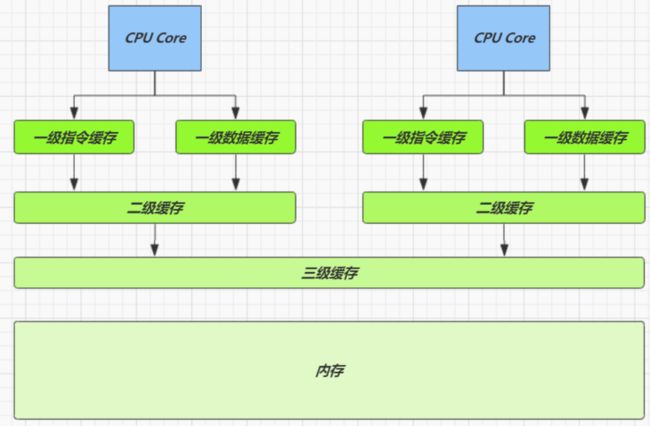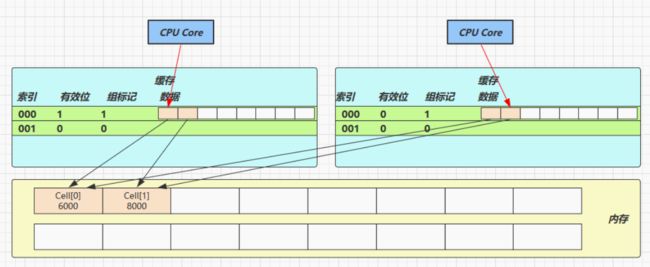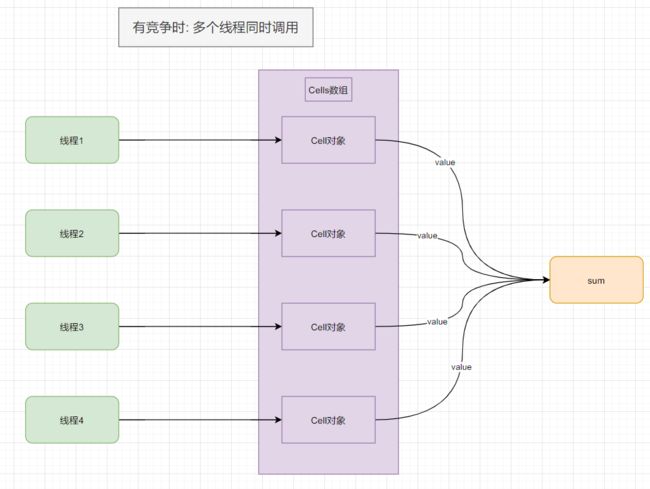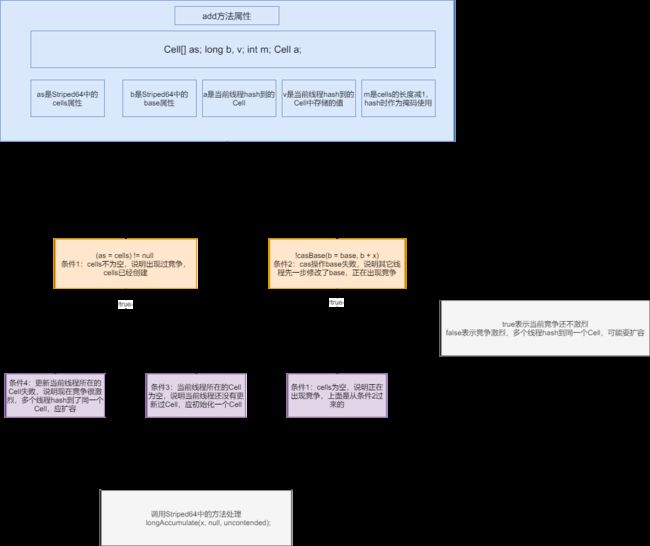longAdder源码解析
参考文章
- https://www.jianshu.com/p/d9d4be67aa56
- https://www.cnblogs.com/dwj-ngu/p/14623349.html
- https://www.cnblogs.com/tong-yuan/p/LongAdder.html
Striped类
//存放Cell的hash表,大小为2的幂。
transient volatile Cell[] cells;
/**
* 基础值,没有竞争时会使用这个值,同时作为初始化table竞争失败的一种方案
* 也就是说没有竞争的时候会使用这个值,如果初始化table竞争失败也会使用这个值
*/
transient volatile long base;
//通过cas实现的锁,0无锁,1获得锁
transient volatile int cellsBusy;
//可用cpu数量
static final int NCPU=Runtime.getRuntime().availableProcessors();
前言
LongAdder 是并发大师 @author Doug Lea (大哥李)的作品,设计的非常精巧
LongAdder 类有几个关键域
// 累加单元数组, 懒惰初始化
transient volatile Cell[] cells;
// 基础值, 如果没有竞争, 则用 cas 累加这个域
transient volatile long base;
// 在 cells 创建或扩容时, 置为 1, 表示加锁
transient volatile int cellsBusy;
CAS锁
我们可以使用 CAS实现锁的功能
package cn.knightzz.atomic.lock;
import lombok.extern.slf4j.Slf4j;
import java.util.concurrent.atomic.AtomicInteger;
/**
* @author 王天赐
* @title: CasLock
* @projectName hm-juc-codes
* @description: 使用CAS实现锁
* @website http://knightzz.cn/
* @github https://github.com/knightzz1998
* @create: 2022-08-08 20:32
*/
@Slf4j(topic = "CasLock")
public class CasLock {
// 0 无锁
// 1 有锁
private static AtomicInteger state = new AtomicInteger(0);
public static void lock() {
log.debug("lock ... ");
while (true) {
// 如果其他线程先拿到锁, state 就会被修改为 1
// 然后就会被一直循环阻塞
if (state.compareAndSet(0, 1)) {
break;
}
}
}
public static void unlock() {
log.debug("unlock ... ");
state.set(0);
}
}
基本思路 :
state.compareAndSet(0, 1)通过设置AtomicInteger类型的state 来实现加锁和解锁- 如果其他线程修该了 state 的值, 那么
state.compareAndSet(0, 1)就会返回false, 然后一直无限循环
原理之伪共享
Cell代码
@sun.misc.Contended
static final class Cell {
volatile long value;
Cell(long x) { value = x; }
final boolean cas(long cmp, long val) {
return UNSAFE.compareAndSwapLong(this, valueOffset, cmp, val);
}
// Unsafe mechanics
private static final sun.misc.Unsafe UNSAFE;
private static final long valueOffset;
static {
try {
UNSAFE = sun.misc.Unsafe.getUnsafe();
Class<?> ak = Cell.class;
valueOffset = UNSAFE.objectFieldOffset
(ak.getDeclaredField("value"));
} catch (Exception e) {
throw new Error(e);
}
}
}
其中 Cell 即为累加单元
缓存与内存
从上面表格可以看到 CPU从寄存器读取数据的速度和从内存中读取数据的速度差异很大, 所以为了提高效率, 在CPU和
内存中间增加了缓存 , 所以在某些情况下就会出现缓存和内存数据不一致的情况出现!
- 而缓存以缓存行为单位,每个缓存行对应着一块内存,一般是 64 byte(8 个 long)
- 缓存的加入会造成数据副本的产生,即同一份数据会缓存在不同核心的缓存行中
- CPU 要保证数据的一致性,如果某个 CPU 核心更改了数据,其它 CPU 核心对应的整个缓存行必须失效
因为 Cell 是数组形式,在内存中是连续存储的,一个 Cell 为 24 字节(16 字节的对象头和 8 字节的 value),因
此缓存行可以存下 2 个的 Cell 对象。这样问题来了:
-
Core-0 要修改
Cell[0] -
Core-1 要修改
Cell[1]
无论谁修改成功,都会导致对方 Core 的缓存行失效,比如 Core-0 中 Cell[0]=6000, Cell[1]=8000 要累加
Cell[0]=6001, Cell[1]=8000 ,这时会让 Core-1 的缓存行失效 , 这俩核心的缓存是放在同一个缓存行里面
@sun.misc.Contended 用来解决这个问题,它的原理是在使用此注解的对象或字段的前后各增加 128 字节大小的
padding,从而让 CPU 将对象预读至缓存时占用不同的缓存行,这样,不会造成对方缓存行的失效
累加方法
累加主要调用下面的方法
public void add(long x) {
// as是Striped64中的cells属性
// b是Striped64中的base属性
// v是当前线程hash到的Cell中存储的值
// m是cells的长度减1,hash时作为掩码使用
// a是当前线程hash到的Cell
Cell[] as; long b, v; int m; Cell a;
// 条件1:cells不为空,说明出现过竞争,cells已经创建
// 条件2:cas操作base失败,说明其它线程先一步修改了base,正在出现竞争
if ((as = cells) != null || !casBase(b = base, b + x)) {
// true表示当前竞争还不激烈
// false表示竞争激烈,多个线程hash到同一个Cell,可能要扩容
boolean uncontended = true;
// 条件1:cells为空,说明正在出现竞争,上面是从条件2过来的
// 条件2:应该不会出现
// 条件3:当前线程所在的Cell为空,说明当前线程还没有更新过Cell,应初始化一个Cell
// 条件4:更新当前线程所在的Cell失败,说明现在竞争很激烈,多个线程hash到了同一个Cell,应扩容
if (as == null || (m = as.length - 1) < 0 ||
// getProbe()方法返回的是线程中的threadLocalRandomProbe字段
// 它是通过随机数生成的一个值,对于一个确定的线程这个值是固定的
// 除非刻意修改它
(a = as[getProbe() & m]) == null ||
!(uncontended = a.cas(v = a.value, v + x)))
// 调用Striped64中的方法处理
longAccumulate(x, null, uncontended);
}
}
as 数组是否为空 or Cell对象未创建
逐行分析上面的代码 :
Cell[] as; long b, v; int m; Cell a;
- as 是 累加单元数组
- b 是基础值, x 是累加值
if ((as = cells) != null || !casBase(b = base, b + x)) {
}
transient volatile Cell[] cells;
回顾原子累加器性能提升的原因 :
性能提升的原因很简单,就是在有竞争时,设置多个累加单元,Therad-0 累加 Cell[0],而 Thread-1 累加
Cell[1]… 最后将结果汇总。这样它们在累加时操作的不同的 Cell 变量,因此减少了 CAS 重试失败,从而提高性
能。
有竞争 : 多个线程调用累加器
然后我们再回到下面的代码 :
if ((as = cells) != null || !casBase(b = base, b + x)) {
}
很显然, 如果有竞争的情况下, 也就是说 cells != null , 就进入 if 的代码块
亦或是没有竞争的情况下, 直接调用 casBase(b = base, b + x) , b 相当于 expectValue , 用于与内存中的值进行对比, b + x 是累加后的值, 如果累加失败, 也会直接进入代码块
然后就是 if 代码块内的代码
if ((as = cells) != null || !casBase(b = base, b + x)) {
boolean uncontended = true;
if (as == null || (m = as.length - 1) < 0 ||
(a = as[getProbe() & m]) == null ||
!(uncontended = a.cas(v = a.value, v + x)))
longAccumulate(x, null, uncontended);
}
-
uncontended表示 cell 没有竞争 -
as == null || (m = as.length - 1) < 0表示累加单元数组尚未创建 -
(a = as[getProbe() & m]) == null ||当前线程的 cell 数组尚未创建, 注意啊getProbe() & m这个是获取当前线程对应的cell 在 cells 的index , 每个线程对应一个 Cell 对象 (a) , 存放在 Cells 数组中 -
!(uncontended = a.cas(v = a.value, v + x)))cas 给当前线程的 cell 累加失败uncontended=false( a 为当前线程的 cell ) -
longAccumulate(x, null, uncontended);进入 cell 数组创建、cell 创建的流程
基本流程图如下 :
LongAdder源码总结
基本策略
LongAdder 的基本策略是 :
- 无竞争状态 : 多线程顺序调用累加方法时, 使用一个基础的 base 值来进行累加
- 有竞争状态 : 多个线程同时调用累加方法时, 让不同的线程更新不同的值cell, 然后把所有的值进行累加
无竞争状态 :
有竞争状态 :
Add方法
add源码 :
public void add(long x) {
// as是Striped64中的cells属性
// b是Striped64中的base属性
// v是当前线程hash到的Cell中存储的值
// m是cells的长度减1,hash时作为掩码使用
// a是当前线程hash到的Cell
Cell[] as; long b, v; int m; Cell a;
// 条件1:cells不为空,说明出现过竞争,cells已经创建
// 条件2:cas操作base失败,说明其它线程先一步修改了base,正在出现竞争
if ((as = cells) != null || !casBase(b = base, b + x)) {
// true表示当前竞争还不激烈
// false表示竞争激烈,多个线程hash到同一个Cell,可能要扩容
boolean uncontended = true;
// 条件1:cells为空,说明正在出现竞争,上面是从条件2过来的
// 条件2:应该不会出现
// 条件3:当前线程所在的Cell为空,说明当前线程还没有更新过Cell,应初始化一个Cell
// 条件4:更新当前线程所在的Cell失败,说明现在竞争很激烈,多个线程hash到了同一个Cell,应扩容
if (as == null || (m = as.length - 1) < 0 ||
// getProbe()方法返回的是线程中的threadLocalRandomProbe字段
// 它是通过随机数生成的一个值,对于一个确定的线程这个值是固定的
// 除非刻意修改它
(a = as[getProbe() & m]) == null ||
!(uncontended = a.cas(v = a.value, v + x)))
// 调用Striped64中的方法处理
longAccumulate(x, null, uncontended);
}
}
基本思路 :
第一个 if 判断 : if ((as = cells) != null || !casBase(b = base, b + x))
-
先判断
cells是否为空 , 如果为空, 说明多个线程还没有开始竞争, 那就直接在 base 上面累加(执行casBase)如果 cells 不为空, 说明已经出现竞争, cell数组已经创建了
-
执行
casBase()方法, 如果执行 casBase方法失败, 那就说明有多个线程同时执行了casBase()方法此时说明有竞争 (有竞争就可以创建
cells数组, 然后每个线程创建一个 Cell 对象用于累加)。
以上两种 : cells 不为空, 或者执行 casBase失败都会进入第二个if判断
第二个if判断 : as == null , (m = as.length - 1) < 0 , (a = as[getProbe() & m]) == null , !(uncontended = a.cas(v = a.value, v + x) :
- 先判断
cell数组是否创建【条件1】, 或者创建了, 但是cells数组中没有Cell对象【条件2】 - 通过hash的方法获取当前线程Cell对象【条件3】 , 如果当前对象为null, 说明还未创建Cell , 此时就初始化一个Cell对象
- 更新当前的Cell对象的值(进行累加)【条件4】,如果更新失败
uncontended=false, 表明竞争激烈, 需要扩容Cells数组
然后执行累加方法 : longAccumulate(x, null, uncontended) , 可能涉及到新建Cell对象或者扩容
简单总结 :
(1)最初无竞争时只更新base;
(2)直到更新base失败时,创建cells数组;
(3)当多个线程竞争同一个Cell比较激烈时,可能要扩容;
longAccumulate
源码注释
final void longAccumulate(long x, LongBinaryOperator fn,
boolean wasUncontended) {
// 存储线程的probe值
int h;
// 如果getProbe()方法返回0,说明随机数未初始化
if ((h = getProbe()) == 0) {
// 强制初始化
ThreadLocalRandom.current(); // force initialization
// 重新获取probe值
h = getProbe();
// 都未初始化,肯定还不存在竞争激烈
wasUncontended = true;
}
// 是否发生碰撞
boolean collide = false; // True if last slot nonempty
for (;;) {
Cell[] as; Cell a; int n; long v;
// cells已经初始化过
if ((as = cells) != null && (n = as.length) > 0) {
// 当前线程所在的Cell未初始化
if ((a = as[(n - 1) & h]) == null) {
// 当前无其它线程在创建或扩容cells,也没有线程在创建Cell
if (cellsBusy == 0) { // Try to attach new Cell
// 新建一个Cell,值为当前需要增加的值
Cell r = new Cell(x); // Optimistically create
// 再次检测cellsBusy,并尝试更新它为1
// 相当于当前线程加锁
if (cellsBusy == 0 && casCellsBusy()) {
// 是否创建成功
boolean created = false;
try { // Recheck under lock
Cell[] rs; int m, j;
// 重新获取cells,并找到当前线程hash到cells数组中的位置
// 这里一定要重新获取cells,因为as并不在锁定范围内
// 有可能已经扩容了,这里要重新获取
if ((rs = cells) != null &&
(m = rs.length) > 0 &&
rs[j = (m - 1) & h] == null) {
// 把上面新建的Cell放在cells的j位置处
rs[j] = r;
// 创建成功
created = true;
}
} finally {
// 相当于释放锁
cellsBusy = 0;
}
// 创建成功了就返回
// 值已经放在新建的Cell里面了
if (created)
break;
continue; // Slot is now non-empty
}
}
// 标记当前未出现冲突
collide = false;
}
// 当前线程所在的Cell不为空,且更新失败了
// 这里简单地设为true,相当于简单地自旋一次
// 通过下面的语句修改线程的probe再重新尝试
else if (!wasUncontended) // CAS already known to fail
wasUncontended = true; // Continue after rehash
// 再次尝试CAS更新当前线程所在Cell的值,如果成功了就返回
else if (a.cas(v = a.value, ((fn == null) ? v + x :
fn.applyAsLong(v, x))))
break;
// 如果cells数组的长度达到了CPU核心数,或者cells扩容了
// 设置collide为false并通过下面的语句修改线程的probe再重新尝试
else if (n >= NCPU || cells != as)
collide = false; // At max size or stale
// 上上个elseif都更新失败了,且上个条件不成立,说明出现冲突了
else if (!collide)
collide = true;
// 明确出现冲突了,尝试占有锁,并扩容
else if (cellsBusy == 0 && casCellsBusy()) {
try {
// 检查是否有其它线程已经扩容过了
if (cells == as) { // Expand table unless stale
// 新数组为原数组的两倍
Cell[] rs = new Cell[n << 1];
// 把旧数组元素拷贝到新数组中
for (int i = 0; i < n; ++i)
rs[i] = as[i];
// 重新赋值cells为新数组
cells = rs;
}
} finally {
// 释放锁
cellsBusy = 0;
}
// 已解决冲突
collide = false;
// 使用扩容后的新数组重新尝试
continue; // Retry with expanded table
}
// 更新失败或者达到了CPU核心数,重新生成probe,并重试
h = advanceProbe(h);
}
// 未初始化过cells数组,尝试占有锁并初始化cells数组
else if (cellsBusy == 0 && cells == as && casCellsBusy()) {
// 是否初始化成功
boolean init = false;
try { // Initialize table
// 检测是否有其它线程初始化过
if (cells == as) {
// 新建一个大小为2的Cell数组
Cell[] rs = new Cell[2];
// 找到当前线程hash到数组中的位置并创建其对应的Cell
rs[h & 1] = new Cell(x);
// 赋值给cells数组
cells = rs;
// 初始化成功
init = true;
}
} finally {
// 释放锁
cellsBusy = 0;
}
// 初始化成功直接返回
// 因为增加的值已经同时创建到Cell中了
if (init)
break;
}
// 如果有其它线程在初始化cells数组中,就尝试更新base
// 如果成功了就返回
else if (casBase(v = base, ((fn == null) ? v + x :
fn.applyAsLong(v, x))))
break; // Fall back on using base
}
}
简单总结
- 有cell数组, 新建cell对象, 然后存入cell数组
- 有cell数组, 但是出现冲突, cell数组需要扩容
- 没有cell数组, 初始化cell数组
- 以上过程都需要锁, 但是当前线程获取不到锁, 直接更新base值
详细解释
先看传参 :
- long x : 累加的值
- boolean wasUncontended , false 表示竞争激烈 需要扩容
然后是获取当前线程的prob值, 每个线程都会有一个随机的值, 这个值参与hash, 因为要把当前线程对应的Cell对象存入Cells数组, 使用的是hash的方式去获取应该存放的数组下标的位置
// 存储线程的probe值
int h;
// 如果getProbe()方法返回0,说明随机数未初始化
if ((h = getProbe()) == 0) {
// 强制初始化
ThreadLocalRandom.current(); // force initialization
// 重新获取probe值
h = getProbe();
// 都未初始化,肯定还不存在竞争激烈
wasUncontended = true;
}
初始化一个值 boolean collide = false; 表示是否出现了 hash 碰撞
然后进入for循环内 :
第一个 if 条件 : 已经初始化过cell数组了
- 先判断cells数组是否初始化(创建)
- 数组中是否已经有Cell对象了
第二个else if 判断 : 未初始化过cells数组,尝试占有锁并初始化cells数组
- 判断
cellsBusy == 0即判断 cellBusy 是否存在锁, 0 表示无锁, 1 表示有锁 - 判断是否创建了多个cell数组, 如果as和cells 不相等, 说明出现了多个 cells 数组
- 尝试获取锁
第三个 else if 判断 : 其它线程在初始化cells数组中
- 如果有其它线程在初始化cells数组中,就尝试更新base , 尝试更新base值,
以上三种情况每种只要执行完为 true , 最后都会 break, 结束循环, 不会同时执行
然后我们回到第一个if 判断 :
判断cell数组是否初始化, 如果已经初始化过了, 那就为 true , 进入代码块 :
简单描述 :
- 当前线程对应的Cell对象没创建, 就创建cell对象, 然后存入cell数组,
- 但是可能会存在多个线程并发问题, 所以要先获取锁, 然后在创建cell对象并存入cells数组
- 存入cell数组的时候, 需要重新获取cells数组, 防止其他线程扩容cell数组
- 执行完成, 释放锁即可 然后break结束
- 当前线程所在的Cell不为空, 说明Cell对象已经创建并且Cell值累加失败
- 注意啊 在 add() 方法里 (uncontended = a.cas(v = a.value, v + x) a 是Cell对象, 累加失败才会进入 longAccumulate
- 设置 wasUncontended = true;
- 再次尝试CAS更新当前线程所在Cell的值,如果成功了就break
- 如果cells数组的长度达到了CPU核心数,或者cells扩容了
collide = false
- 设置collide为false并通过下面的语句修改线程的probe再重新尝试
- 上上个elseif都更新失败了,且上个条件不成立,说明出现冲突了
collide = true;
我们到第二个 else if 判断 : 明确出现冲突了,尝试占有锁,并扩容
简单描述
- 检查是否有其它线程已经扩容过了
cells == as
- 数组大小扩容一倍
- 把旧数组元素拷贝到新数组中
- 重新赋值cells为新数组
- 释放锁
- collide = false; 已解决冲突
- 跳过当前循环, 然后重试
第三个 else if 判断 : 未初始化过cells数组,尝试占有锁并初始化cells数组
-
获取锁
-
检测是否有其它线程初始化过
cells == as -
创建Cell数组
- 新建一个大小为2的Cell数组
- 找到当前线程hash到数组中的位置并创建其对应的Cell
- 赋值给cells数组
- 初始化成功
init = true; - 释放锁
-
初始化成功直接返回 break
-
为增加的值已经同时创建到Cell中了






